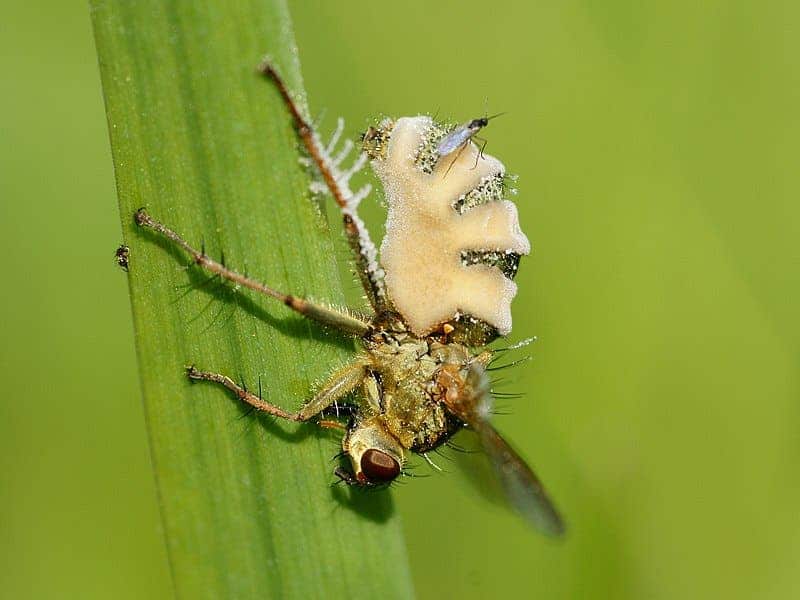Nature can be unfathomably beautiful and rich, but it can also be scary and cruel. Take this unique fungus for instance, whose dirty tricks biologists are just beginning to figure out. According to a ghastly new study that appeared this week, the fungus infects flies and turns them into zombies at the beck and call of the microbe. If that wasn’t enough, once the fly is dead, it releases irresistible sex pheromones that invite male flies to mate with the corpse, thereby infecting them and resetting the cycle of doom.

“The chemical signals act as pheromones that bewitch male flies and cause an incredible urge for them to mate with lifeless female carcasses,” explains Henrik H. De Fine Licht, an associate professor at the University of Copenhagen.
“Our observations suggest that this is a very deliberate strategy for the fungus. It is a true master of manipulation—and this is incredibly fascinating.”
The strategy of the parasitic fungus Entomophthora muscae is as effective as it is machiavellian, tapping into the power of lust. To demonstrate how, the researchers at the University of Copenhagen conducted a series of experiments in which male house flies were introduced to both infected and non-infected dead females within the same testing enclosure.
They found that when the infected dead female was in the late stage of spore release, the males would perform a higher number of mating attempts with both the infected and non-infected remains, presumably because the infected body released sex pheromones called sesquiterpenes across the entire enclosure.
Specifically, 73% of the male flies in the study mated with female fly carcasses that had died from the fungal infection 25-30 hours earlier, whereas only 15% of the males mated with females that had been dead for only 3-8 hours.
This shows that the longer a female fly is dead, the more alluring it becomes to the males, which become unwilling necrophiliacs. And as the males become bathed in the spores while touching the infected remains, they too suffer the same gruesome fate. Almost three-quarters of males exposed to infected dead females with late-stage sporulation died, compared to only 15% of males who tried to copulate with fresh carcasses in the early stage of sporulation. But before they succumb, the flies first have to submit to the fungus.
Once spores infect flies, they grow into a fungus that extends into the part of the brain that controls the insect’s motor movements. The infected fly is eventually forced to fly and crawl to the highest point possible, such as high up on a wall or perched on tall vegetation, where spore release is the most optimal for infecting new hosts.
So the spores of Entomophthora muscae can be a double whammy, on the one hand compelling its hosts to serve its interests, and on the other enticing new hosts to join its ranks.
That’s pretty gruesome, yet strangely fascinating. In any event, the researchers think they can learn from these mechanisms and weaponize the spores as effective pest repellents in the future.
“Flies are quite unhygienic and can sicken humans and animals by spreading coli bacteria and any diseases that they are carrying. So, there is an incentive to limit housefly populations, in areas where food is being produced for example,” De Fine Licht says.
“This is where the Entomophthora muscae fungus may prove useful. It might be possible for us to use these same fungal fragrances as a biological pest control that attracts healthy males to a fly trap instead of a corpse.”
The findings appeared in the ISME Journal.









